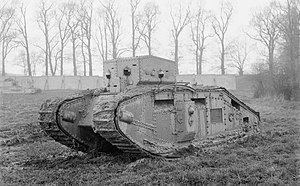Medium Mark B
| Medium Tank Mark B | |
|---|---|

Medium Tank Mark B. The machine guns are missing from their mounts in the superstructure and in the projecting doors on the sides
|
|
| Specifications | |
| Weight | 18 tons |
| Length | 22 ft 9 in (6.9 m) |
| Width | 8 ft 10 in (2.7 m) |
| Height | 8 ft 6 in (2.6 m) |
| Crew | 4: commander, driver, mechanic, machine gunner |
|
|
|
| Armour | 14 mm-6 mm |
|
Main
armament |
4 x .303 in (7.92 mm) Hotchkiss machine guns to be placed in seven possible ball-mounts |
|
Secondary
armament |
- |
| Engine |
Ricardo 4-cylinder petrol 100 hp (75 kW) |
| Power/weight | 5.6 hp/tonne |
| Suspension | unsprung |
|
Operational
range |
105 km or 65 miles |
| Speed | 6 mph (10 km/h) |
The Medium Mark B was a British tank of the First World War developed as a successor to the Whippet, but ultimately unsatisfactory and production was cancelled at the end of the war.
The engineer Lieutenant Walter G. Wilson and the industrialist Sir William Tritton had cooperated in 1915 to develop the Mark I, the world's first tank. However, when Tritton decided to build the Medium Mark A "Whippet", Wilson was left out. The Medium A was designed by Tritton's chief engineer, William Rigby. The Whippet was a successful design and proved effective but suffered from a lack of power, complex steering and unsprung suspension. Wilson, now a Major, decided he could by himself develop a better tank as replacement: the 'Medium Tank Mark B'. He probably started drawing in July 1917. Major Philip Johnson of Central Tank Workshops was impressed when he was shown a wooden mock-up during a visit to Britain late 1917. The prototype was built by Tritton's firm, the Metropolitan Carriage and Wagon Company, and was finished in September 1918.
It seems that early in the design process Wilson considered building an alternative or parallel Male version fitted with a 2-pounder (~40 mm gun) in the superstructure but he had abandoned these plans by March 1918.
The design by Wilson had elements of both the Mark I and the Whippet: a similar but smaller tracked rhomboid chassis of the former and fixed turret like the latter. A novel feature was the separate compartment in the back, housing the 100 hp (75 kW) engine (a four-cylinder shortened Ricardo design) and behind it the epicyclic transmission. Two fuel tanks at the back held 85 imperial gallons (386 L) of petrol. Other innovations were the ability to lay a smoke screen and the use of sloped armour in the front of the hull. The smoke screen device consisted of a sulphonic acid reservoir located over the exhaust pipe. Armament consisted of a maximum of five machine guns in the superstructure and two in the side doors. These hull doors looked a bit like miniature sponsons. The machine guns were removable and in practice fewer guns would have been taken along, the machine-gunner moving his gun when switching position; most sources give an estimate of four.
...
Wikipedia
